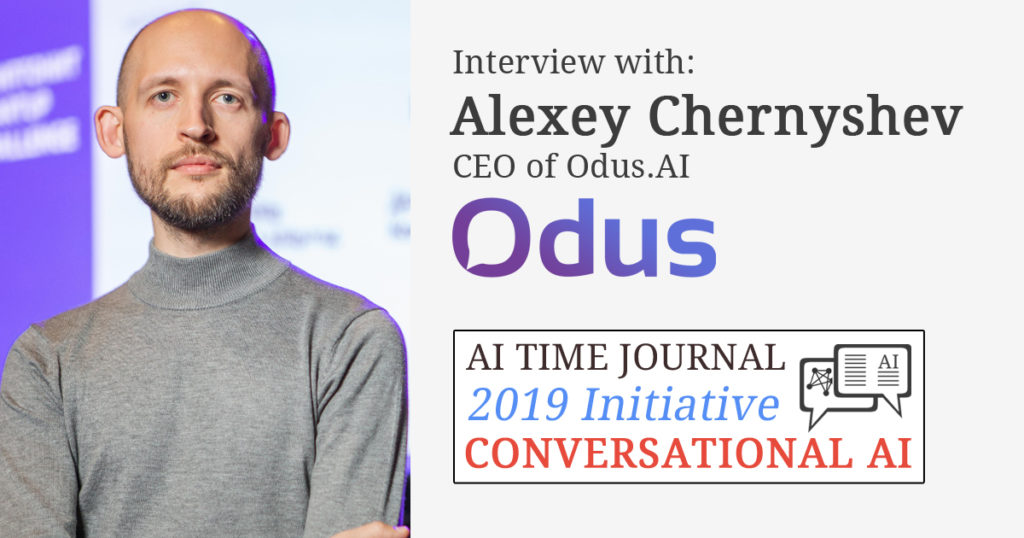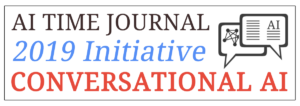
Alexey Chernyshev is the CEO of Odus.AI, a company that develops a multi-channel conversational AI platform that helps enterprises scale customer support operations regardless of their size through an intuitive visual interface without the need to learn to code.
In this interview, Mr. Chernyshev shares insights on how enterprises can start adopting conversational AI interfaces to solve both small customer support tasks and complex operations with the ultimate goal of improving their relations with customers.
This interview has been featured in the Conversational AI Initiative 2019.

What is your background and how was Odus started?
My name is Alexey Chernyshev, I’m a CEO and co-founder. I started my first business 10 years ago, it was a mobile app for booking a taxi online. Yeah, that’s when Uber launched, too. After that, I had 5 companies in several IT industries. And two years ago, I created a digital agency. We started developing chatbots for clients when it had been a rising trend. One year after launch, I got an insight into this market and decided to scale our solution outside the frame of the simple custom development, because we created our own AI core and we wanted to help more companies.
What is Odus‘s mission?
Odus’s global mission is to help companies make their customers happy. As we know, communication with the consumer is one of the main parts of success. We help businesses to be in touch with any number of customers, regardless of the size of the company itself.
Walk us through Odus’s products, and what problems they solve.
This is a cloud platform with its own AI-based conversation technology. We don’t have many products, but the platform can be used in your business in many ways. Here, you can create a simple virtual assistant and connect it to different communication channels: Messenger, Telegram, WhatsApp and Voice Calls via Twilio or Voximplant, a click-to-call button for websites, web-widget and a landing page bot. Or the company may contact us for complex and custom development.
All our virtual assistants are based on customer’s intents, entities and dialogs, not on buttons or primitive funnels. This allows you to create human-like robots. And all this can be done through an intuitive visual interface without the need to learn to code.
We help reduce the amount of manual work and reduce costs on call centers and operators. First of all, we automate the first line of customer support without compromising the quality of service.
When the Internet appeared, he gave us websites. When mobile applications appeared, we got a convenient tool for solving any problems. Now, it’s the time of smart speakers and other things. Voice interfaces begin to appear everywhere and soon your refrigerator will start talking to you.
What are the biggest challenges that you are currently facing at Odus?
Initially, we focused on small businesses. But after some time, we changed our focus to the medium and large segment because small businesses don’t have enough data for AI. In most small businesses, business processes are not formed. This is not a reason to abandon this tool. You just can’t take advantage of some features.
As for technology, all companies in our field are trying to learn how to understand natural speech as best as possible. We have learned to do this quite well and better than many in the market. But we are still far from ideal.
How do you measure the performance of your products?
Each client has its own parameter. Someone measures by the number of orders, someone by the speed of processing the request to the support service. The main indicator is the growth of the client’s key metric, subject to cost reduction. We have an analytics section on the platform for this. And we also connect any external analytics web-services.
Tell us about the Odus team.
Odus is founded by three people, including me. I’m responsible for strategy and sales, Valentin is responsible for the brain of the platform, and Ilya for everything that our user sees. Also, we have four employees. Three developers and a product manager. The team is remote and live in three countries. All our team members have extensive experience in corporations. Such a team is not easy to manage but it provides cost benefits.
To get started, it’s enough to introduce a voice assistant to solve simple problems. Interviews with new employees, answers to questions in the support service, the implementation of internal business tasks. These are the processes in which enterprises already have historical data, so that can be analyzed and patterns determined.
What is your experience with voice-enabled interfaces?
As a user, I started using Siri several years ago. My wife uses it every day. I also often use voice input for notes. I always liked voice assistants and I constantly study how they work. I’m more comfortable talking with the robot because I can think before answering. I don’t need to concentrate all my attention on the dialog as it happens in the dialog with a human.
What opportunities do voice-enabled interfaces bring for enterprises?
First of all, this is a colossal reduction in expenses on call centers and operators. It also reduces the time spent on data entry, for example, writing medical reports. Managing many machines will be easier, especially where the operator’s hands are often occupied.
But the main thing is that working with the software will become much easier and you won’t have to create complex visual user interfaces. And this means the ability to automate many business processes.
How can enterprises get started with their conversational ai strategy?
To get started, it’s enough to introduce a voice assistant to solve simple problems. Interviews with new employees, answers to questions in the support service, the implementation of internal business tasks. These are the processes in which enterprises already have historical data, so that can be analyzed and patterns determined. If you immediately try to solve a large and difficult task, then this project can take a lot of time and ultimately not bring the expected result.
Enterprises should become simpler and minimize bureaucracy in communication with the client. The fewer obstacles to solving a client’s problem, the better. Conversational interfaces have nothing to do with it.
How can enterprises prepare for the changes in the industry brought by Conversational AI technology?
They should become simpler and minimize bureaucracy in communication with the client. The fewer obstacles to solving a client’s problem, the better. Conversational interfaces have nothing to do with it. This will expose long-standing problems that no one paid attention to before. It is unlikely that you will want to dictate a complex request or answer twenty questions, right?
So, it is definitely important to collect data and statistics of dialogs within the company or with clients right now. Organize and markup this information, it will be very difficult to create a quality solution without it.
What are the biggest opportunities for enterprises to leverage Conversational AI?
What are the biggest opportunities for enterprises to leverage websites? It’s the same. When the Internet appeared, he gave us websites. When mobile applications appeared, we got a convenient tool for solving any problems. Now, it’s the time of smart speakers and other things. Voice interfaces begin to appear everywhere and soon your refrigerator will start talking to you. The main opportunity is access to a completely new channel of communication with the consumer. And on this channel, there is minimal competition in comparison with online advertising, at the moment.
How can enterprises leverage Conversational AI to make their customers happier and more satisfied?
In today’s world, people don’t like to wait. Therefore, a timely response 24/7 is very important. Not all companies are ready to answer you at night, on weekends and holidays. But your clients have different situations in life. Many are ready to solve their everyday problems only on the weekend, for example. In such a situation, it is much more profitable to use a robot instead of a contractor in the form of a call center or increasing the staff of operators.
From my own experience and the experience of our users, I know that many customer issues can be resolved automatically without the participation of your employees. Provide information, send a file, fill out an application, etc.
Reminding the customer of an upcoming service by calling or writing a message is also useful. You don’t need to hire an employee for this, just set up the robot.
Which Conversational AI-related technology trend do you think will have the biggest impact in your industry in the coming years?
High-quality speech synthesis, assessment of emotions, understanding of the context of dialogue. All these technologies are very important and they are already developing very rapidly.
But it’s far more important to learn to understand the meaning of deep dialogue using vague expressions when it is not clear what the answer or question relates to. We have already learned to understand this quite well, but in difficult situations, even our system can fail. Once we find a solution to this problem, you will not be able to distinguish our robot from humans.
